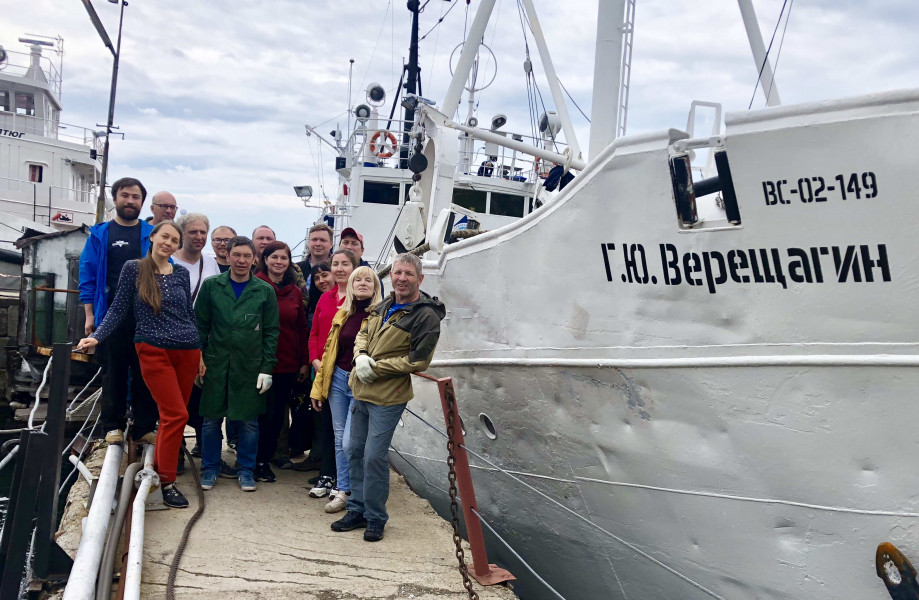Expedition on R/V “G.Yu. Verschagin” from June 22 to July 01, 2021
An expedition was performed on board of R/V “G.Yu. Vereshchagin” in reference areas and in the areas of hydrocarbons discharge in Southern, Central and Northern Baikal within the State Assignments 0279–2021–006 “Studies of functioning of hydrate, oil and gaseous hydrocarbon systems and associated microbial communities in Lake Baikal” (Leader Dr. T.I. Zemskaya) and 0279-2019-0003 “Ecological and economic assessment of functioning of freshwater biogeocenoses, basic and applied aspects” (Leader PhD M.M. Makarov).
The aim of the expedition was to study composition of biocoenoses, seek for new non-culturable lines of microorganisms in the zones of anomalies of temperature field and fluids in Lake Baikal water body and sediments.
All planned expedition activities were completed at 13 stations. Water was sampled in Southern and Central Baikal using a Rozetta system of bathometers. >40 cores of sediments were sampled by means of a gravity corer; 15 cores were subjected to diatom analysis. 30 sediment samples were collected in the reference area of Northern Baikal with a bucket grab. Lithology, pH, Eh, Т and oxygen content (in pore water) were measured in sediments of this area. 208 sediment samples and 17 water samples were collected to determine methane concentrations. To determine chemical composition of pore waters, ca. 500 bottom sediments samples were taken.
Shallow water hydrate seeps, where gas and oil discharge (mouth of the Zelenovskaya River) as well as sediment of mud volcano Kedr were studied. The main purpose of the investigations was to find an impact of environmental conditions and geodynamic situation on the functioning of sub-bottom (near-surface) gas hydrates systems at the boundary of their stability. Bathymetric data in these areas are completed by geophysical methods. Experiments for obtaining accumulation cultures from the sediments in the area of oil and gas discharge (the Zelenovskaya River) were started. There are plans to study phylogenetic diversity and the role of microbial communities in anaerobic processes of oil oxidation. Sediments containing two different generations of authigenic carbonates in the area of mud volcano Kedr to determine isotopes of DIC and 13С in carbonate as well as to find out and study taxonomic diversity of microbial communities were sampled. Laboratory experiments to study the role of microorganisms in formation of authigenic carbonates in methane atmosphere with addition of different carbon sources were started.
Distribution of colorless sulfur bacteria of the genus Thioploca in the areas of discharge of gas and oil containing fluids was studied. The samples of sulfur bacteria will be used to find out their taxonomic identity and metabolism peculiarities on the base of the analysis of their complete genomes. Some approaches will be tested to obtain a DNA useful for a deep metagenomic analysis.
In order to find out the dynamics of biogeochemical situation, sediments were sampled in the area of methane seep Krasny Yar to extract total DNA and to analyze chemical composition of pore waters. Data on taxonomic composition of microbial communities and on pore water chemistry obtained in the expedition will be compared to the data 2016.
Sediments (each 1 cm) and iron-manganese crusts were sampled in the area of the Big Ushkan Island. There are plans to study their chemical and mineral composition, to find out the age of their formation as well as to study taxonomic composition of microbial communities using molecular biology methods.
Water in the pelagic zone, near-bottom water and surface sediments were sampled for experimental cultures of methanotrophic bacteria in the area of methane discharge in Southern and Central Baikal; they will also be studied to find out taxonomic composition of natural microbial communities. Experiments for culturing of accumulative cultures of methanogenic and anaerobic methanotrophic Archaea from reduced samples in the areas of hydrocarbon discharge as well as of thermophilic prokaryota from bottom sediments in hydrate bearing oil and gas seeps were started. Bottom sediments were sampled from deep water area of hydrocarbons discharge “MSU” from sediment depth of 0-5 cm and 200-210 cm.
Participants of the expedition: employees of Limnological Institute (Laboratory of Hydrocarbon Microbiology, Laboratory of Lake Baikal Geology, laboratory of Hydrology and Hydrophysics, Laboratory of Hydrochemistry and Atmosphere Chemistry, Laboratory of Interdisciplinary Studies of Environmental and Economic Studies and Technologies), Institute of Inorganic Chemistry of RAS SB (Novosibirsk), Research Institute of Oceanology (Saint-Petersburg).




